I didn’t watch the presidential debate on Tuesday night. As usual, I was at Dodger Stadium.
Also as usual, climate change was on my mind.
During the second inning, an acquaintance sitting in the Top Deck texted me a photo of ominous smoke clouds looming over the San Gabriel Mountains, a product of the 49,000-acre Bridge fire — one of several climate-fueled blazes that have exploded across Southern California over the last few days, signaling a potentially dangerous autumn, as The Times’ Hayley Smith reports.
Smoke from the Bridge fire is visible from Dodger Stadium — with a prominent ad for gas station chain 76 in the foreground, just above the scoreboard.
(Nicolas Gonzalez)
Before the game, I had spent most of the day in Anaheim, at a solar industry convention known as RE+. More to come next week on what I learned. But at Dodger Stadium on Tuesday night, I found myself thinking about the convention attendee I’d overheard commenting on the scorching weather. An intense heat wave was finally subsiding; the high temperature in Anaheim on Tuesday was 82 degrees, down from 95 on Monday and 101 on Sunday. Did out-of-town visitors have any idea how lucky they were?
And by “lucky,” I don’t just mean “lucky not to be more uncomfortable.” Heat kills.
This past Sunday, in fact, 35-year-old Orange County resident Bobby Graves collapsed and died after competing in Disneyland’s Halloween Half Marathon, not far from the Anaheim Convention Center, as my L.A. Times colleague Jireh Deng reports. Although the coroner is still investigating the cause of his cardiac arrest — and the half marathon started at 5 a.m. — it’s well documented by scientists that heat-related deaths are on the rise as coal, oil and natural gas combustion raise global temperatures.
A day before the half marathon, Graves shared his concerns about the heat wave on TikTok.
“I was outside for like 20 minutes walking my dog,” he said. “Ten minutes later after I came back in, I just passed out.”
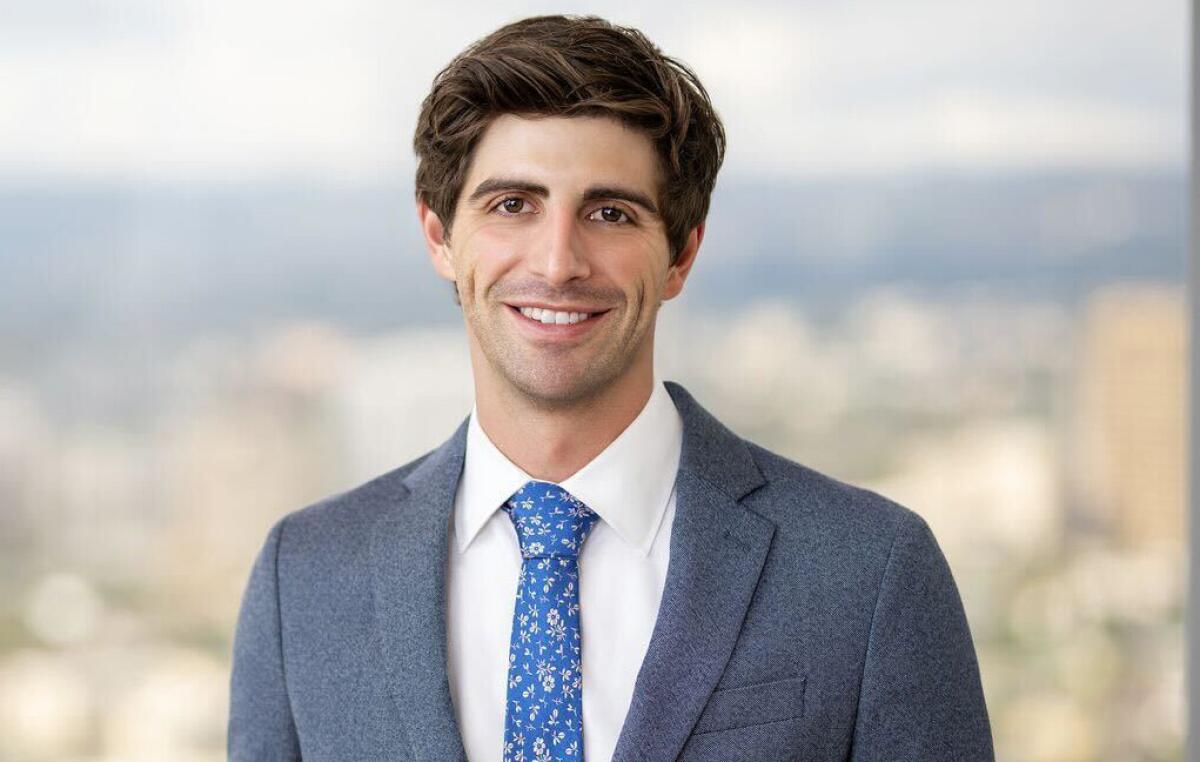
Bobby Graves went by his middle name, Caleb.
(Wilson Sonsini)
In related news, European Union scientists and officials declared summer 2024 the planet’s hottest ever measured. (Details here from Hayley Smith and Sean Greene.) Phoenix residents have suffered more than 100 straight days of 100-degree temperatures.
Fortunately, California hasn’t returned to the power shortages and rolling blackouts that plagued the state during a hot spell four years ago, or the pleading “use less energy!” text messages sent by the governor’s office during another heat wave in 2022. That’s largely because we’ve installed lots of batteries, capable of storing solar power during the afternoon and saving it for hot evening hours, when the sun goes down but people continue blasting their air conditioners, as E&E News’ Benjamin Storrow reports.
That doesn’t mean the power has stayed on for everyone.
The heat caused power grid equipment to fail in places, forcing the Hollywood Bowl to cancel a concert. Between the Los Angeles Department of Water and Power and Southern California Edison, 10,000 homes and businesses didn’t have power on Monday.
Pasadena Water and Power, meanwhile, announced it was forced to implement rolling blackouts after high temperatures spurred equipment failures at its gas-fired Glenarm power plant. Something to keep in mind the next time you hear a politician or pundit claim that that renewable energy can’t keep the lights on without fossil fuels. This was a “reliable” fossil fueled power plant failing to do its job because of climate-exacerbated extreme weather — not an uncommon occurrence, as I’ve reported previously.
All of which brings us back to Dodger Stadium, and the presidential debate.
With the heat wave receding, Tuesday was a pleasant night to enjoy a game at Chavez Ravine.
But Sunday’s game-time temperature was so high — 103 degrees at 1:10 p.m., tying a Dodger Stadium first-pitch record, as The Times’ Jack Harris noted — that the Dodgers distributed free water bottles. The San Diego Padres did the same thing on Sunday.
There’s a cruel irony here.
Shortly after the wretchedly hot afternoon game got started, the Bridge fire ignited in the San Gabriels. I was at the ballpark the previous evening, watching the Dodgers play the Cleveland Guardians in what I couldn’t help but dub as “Fossil Fuel Night.”
The temperature at first pitch (6:10 p.m.) was 91 degrees. The Dodgers gave out bobbleheads of reliever Evan Phillips sponsored by oil company Phillips 66 — the same company whose 76 gasoline advertisements are plastered all over the stadium, and whose longtime sponsorship I’ve written columns urging Dodgers owner Mark Walter, a dedicated wildlife conservationist, to drop.
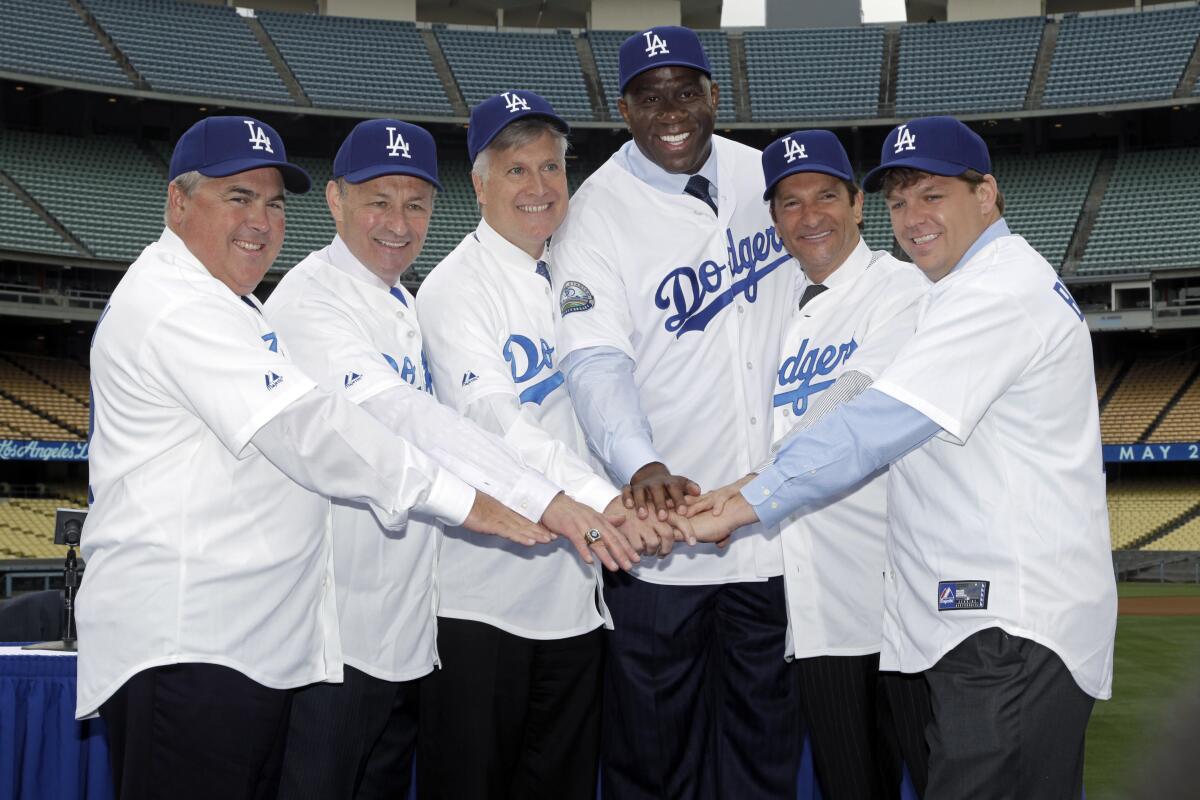
Mark Walter (third from left) poses with other members of the Dodgers ownership group, including Magic Johnson (fourth from left), at Dodger Stadium in 2012.
(Damian Dovarganes / Associated Press)
The icing on the cake? The opposing team, the Cleveland Guardians, was wearing Marathon Petroleum jersey patches.
As I’ve reported previously, the Ohio-based company owns the Arco gas station chain, another major Dodger Stadium advertiser, as well as a Los Angeles-area oil refinery that poisons the air breathed by millions of people, especially people of color. (Phillips 66 owns another such South Bay refinery.) Marathon has also sponsored events for kids hosted by the Dodgers’ official charity.
Some people ask me why I keep bringing up this baseball stuff, instead of spending more time on energy policy or state politics. The main reason — beyond the fact that I like the Dodgers a lot — is that studies and experts have convinced me it matters.
If one of the country’s highest-profile sports franchises were to take a courageous stand and reject fossil fuel greenwashing, the ripple effects — across sports, the media and culture — could be enormous. Those effects might take time to play out. But where the Dodgers lead, others follow. That’s how it happened when Jackie Robinson and Branch Rickey integrated baseball. That’s how change works. There’s always backlash; history lionizes you as a hero, but until then a lot of people castigate you as a villain.
The Dodgers won on Saturday, 7-2. Tuesday night was a clunker by comparison, a 6-3 loss to the Chicago Cubs.
After the game on Tuesday, I did want to know what, if anything, the presidential candidates had said about climate change.
I was disturbed but not surprised to learn, reading Lisa Friedman’s story for the New York Times, that the ABC News moderators asked exactly one question about global warming during the 90-minute debate, and it was the final question of the night.
Asked what they would do to fight climate change — and told by ABC’s Linsey Davis that climate issue is of particular concern to “younger voters,” which doesn’t track with data showing that younger and older registered voters are almost equally likely to say climate could influence their decisions — former President Trump said little even remotely related to global warming.
Trump “is virtually incomprehensible on the topic of climate change,” Friedman wrote. “On Tuesday night, he said he was a ‘big fan” of solar power but then complained that solar farms take up too much space. He has railed against electric vehicles but then also said he was a ‘big fan’ after receiving an endorsement from Elon Musk, the head of Tesla. Asked about global warming, the former president typically says the greater threat is ‘nuclear warming,’ by which he seems to mean nuclear war.”
Vice President Kamala Harris was better than her Republican opponent, acknowledging the threats posed by rising temperatures and pointing to her role in passing the Inflation Reduction Act, a landmark clean energy and jobs bill signed by President Biden.
But the Democratic nominee also bragged that under Biden, the U.S. has “increased domestic gas production to historic levels” — a true but nonetheless startling fact for Harris to highlight. Especially when her campaign has yet to release a climate platform.

Former President Trump and Vice President Kamala Harris are shown on a monitor in the spin room during the presidential debate on Tuesday.
(Hannah Beier / Bloomberg via Getty Images)
I can only assume that Harris is attempting to win certain swing states by appealing to politically moderate voters who, in theory, are more likely to vote for her if she sounds less radical — a classic Democratic Party strategy. I have no idea if it will work.
But I do know there are many young climate activists who were fed up with Biden, despite his litany of significant achievements. And as I learned while reporting Tuesday’s Boiling Point, even those who have embraced Harris have still been waiting patiently to hear more from her on climate. And others haven’t yet committed to voting for her, waiting to gauge her level of commitment.
For those climate-motivated voters, Tuesday’s debate must have felt like a gut punch.
“Tonight, Harris spent more time promoting fracking than laying out a bold vision for a clean energy future. That’s a big missed opportunity,” the Sunrise Movement wrote on X. “With an election this close, every young climate voter we turn out matters.”
Again, I have no idea what will happen in November. I understand even less about politics than most political pundits do.
But if Harris is banking on climate voters turning out for her no matter what, she may want to be careful.
Sooner or later, we’ll need to find our way out of the trees and start seeing the forest. We’re running low on time.
Until then, here’s what’s happening around the West:
OUR CLIMATE CHANGE CHALLENGE
As I noted on Tuesday, the L.A. Times is publishing a special edition about the climate crisis this week. There will be a full section in print this Sunday, which you can order online here. Here are some new pieces that have published online since Tuesday:
- Is climate anxiety a mental health condition or a cultural phenomenon? And why do we need to understand it not just in terms of “climate,” but also the many other stressors that affect marginalized communities? Here’s a thoughtful, important essay by Rosanna Xia. If you’re feeling anxious, Rosanna also has recommendations for books that offer climate hope.
- The fashion industry could account for as much as 8% of the world’s climate pollution. So what are fast fashion brands doing to clean up their act? Not a lot, Stephanie Yang reports. It doesn’t help that consumers don’t seem to care too much.
- Climate disasters can keep you up at night. They can also inspire you to action. That’s been the case for many young people, who have turned to social media to raise awareness about the climate crisis, as The Times’ Melissa Gomez reports.
- Melissa also wrote about climate scientists using social media to explain their work to the public — often with a dash of hope.
Want to join me and my colleagues for a discussion of these climate challenges and others? The L.A. Times is hosting “California Climate Live” on Thursday, Sept. 26 at 9 a.m., at the Colburn School in downtown Los Angeles. You can buy a ticket here.
Can’t make it to the event, but still want to support our climate journalism? Please consider an L.A. Times digital subscription.
POLITICAL CLIMATE
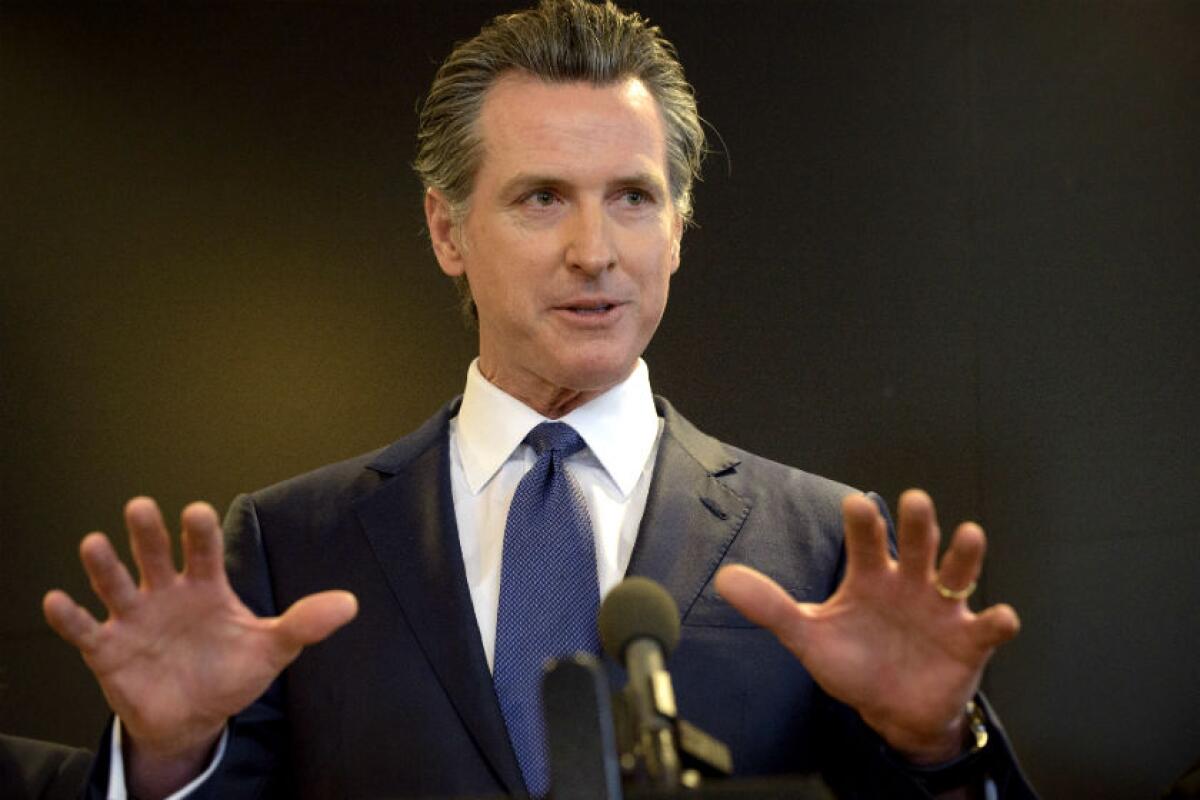
California Gov. Gavin Newsom speaks at a news conference in Sacramento in February.
(Associated Press)
Let’s start in the Golden State, whose climate leadership is not as straightforward as its leaders would have you believe:
- Are employers complying with California’s new rules to protect indoor workers from extreme heat, which finally took effect this summer after years of delay? Some yes, some no. (Story by Rebecca Plevin and Suhauna Hussain, L.A. Times)
- State officials say the state has conserved 25% of its land and 16% of its coastal waters and is making progress toward Gov. Gavin Newsom’s “30 by 30” goal. Federal national monument designations have helped. (Hayley Smith, L.A. Times)
- Speaking of which, the Biden administration is preparing to designate Chumash Heritage National Marine Sanctuary off the Central Coast, at the Northern Chumash Tribe’s urging. It will be four times the size of Yosemite. (Paul Rogers, Mercury News)
- Lawmakers want President Biden to create a national monument near Mt. Shasta. (Kurtis Alexander, San Francisco Chronicle)
One more thing: Newsom has spent a lot of political capital lately battling Big Oil, in an effort to reduce gas prices (or at least convince the public he’s trying to reduce gas prices). After state legislators rejected Newsom’s demand to pass a bill that could result in refineries being required to stockpile fuel in case of shortages — which, in theory, could help mitigate price shocks at the pump — the governor ordered the Legislature to reconvene in special session to debate and pass such a bill.
Newsom’s latest demand didn’t go over so well, with state Senate leader Mike McGuire (D-Healdsburg) refusing to call lawmakers back to Sacramento. But McGuire ultimately backed down a bit, telling L.A. Times columnist George Skelton that he would call the Senate back into session in the fall — as long as the Assembly, led by Speaker Robert Rivas (D-Hollister), passes a bill first.
Politics! I’m sure it makes sense to somebody.
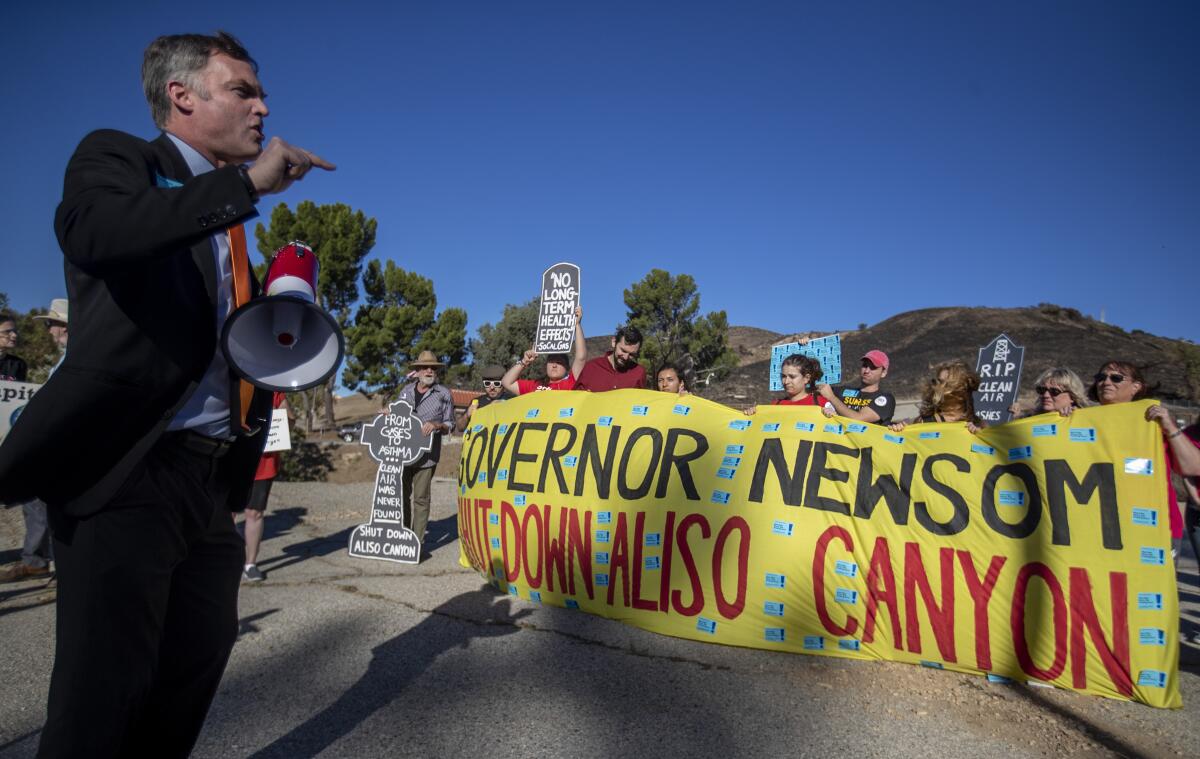
Darrell Park, a former candidate for Los Angeles County supervisor, speaks at a 2019 rally in L.A.’s Porter Ranch neighborhood marking the fourth anniversary of the Aliso Canyon methane blowout.
(Brian van der Brug / Los Angeles Times)
I was also reminded, via this story by the L.A. Daily News’ Olga Grigoryants, that Newsom once called for shutting down the Aliso Canyon gas storage field — which is owned by Southern California Gas and is best known for a record-breaking methane leak — no later than 2027. It’s been years since Newsom highlighted that commitment, and the agency studying the storage field’s future, the California Public Utilities Commission, seems inclined to keep it open for many years to come.
There are intriguing political goings-on in other Western states, too:
- In a remarkable lawsuit filed directly with the U.S. Supreme Court, Utah is seeking to wrest control of about one-third of the state’s land from the federal government. The suit is paired with a bizarre ad campaign full of historical (and contemporary) fallacies. (Hannah Schoenbaum and Matthew Brown, Associated Press; Jonathan P. Thompson, Land Desk)
- Federal officials are making it slightly harder to drill for oil and gas and slightly easier to build renewable energy across 3.6 million acres in southwest Wyoming. Would you believe there’s controversy? (Jake Bolster, Inside Climate News)
- The latest at Grand Staircase-Escalante: “Next time a Utah politician or wannabe sagebrush rebel whines about how the BLM or the Biden administration or national monuments are destroying ranching, show them this.” (Jonathan P. Thompson)
- The planned Lava Ridge wind farm, which if built would be Idaho’s largest wind farm, was dealt a possible setback, stemming from long-running criticism over the project’s proximity to Minidoka National Historic Site. Minidoka preserves the memory of a Japanese American prison camp operated by the federal government during World War II. (Scott Streater, E&E News)
Let’s close this section with some dollar signs, and some large numbers:
- Chevron will pay Richmond $550 million over 10 years in exchange for the Bay Area city agreeing to pull a ballot measure that would have added taxes on the company’s oil refinery. Seems the tax could have cost even more. (Dan Brekke, KQED)
- L.A. Metro is getting $893 million in federal funds for rail service in the San Fernando Valley. (Salvador Hernandez, L.A. Times)
- California is getting $150 million in federal funds for thousands of electric car charging ports. (Colleen Shalby, L.A. Times)
- The National Park Foundation is getting a record $100-million gift from Lilly Endowment. (Patrick Whittle, Associated Press)
WATER AND FIRE
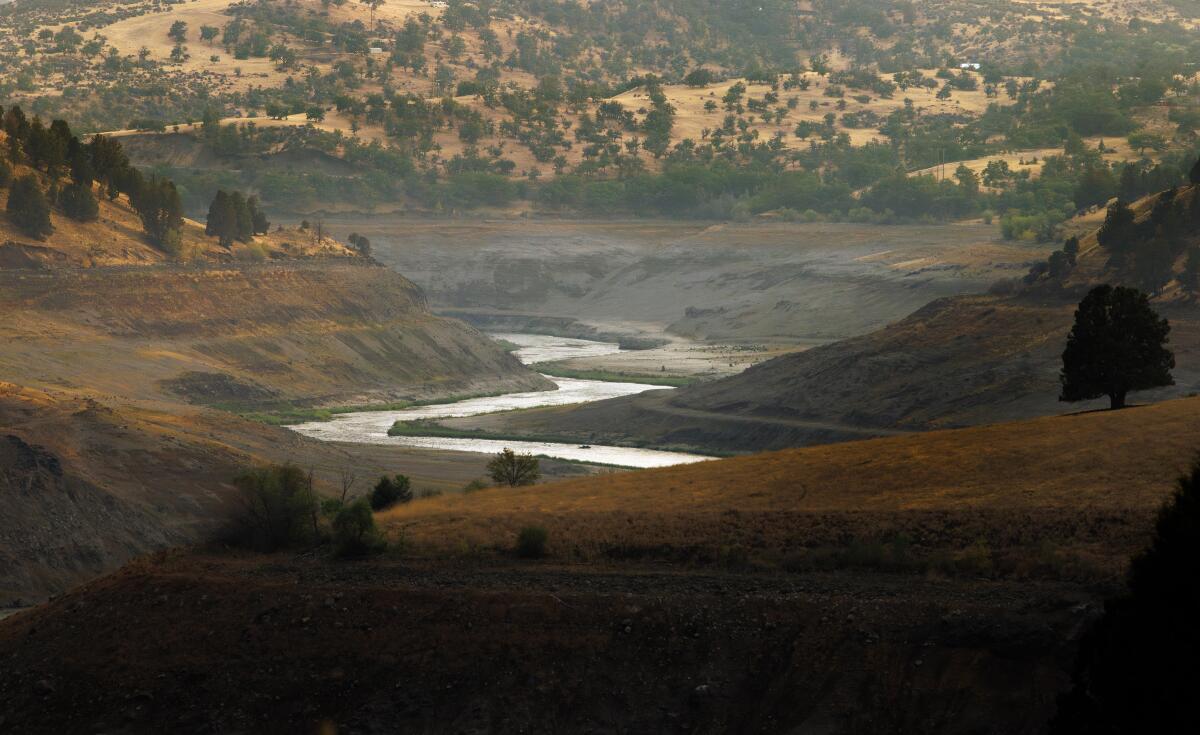
The removal of dams and the draining of reservoirs has enabled the Klamath River to return to its historic channel.
(Gina Ferazzi / Los Angeles Times)
Four dams along the Klamath River are gone — and after decades of fighting to restore the river, members of the Yurok and Karuk tribes are feeling hopeful. If you’re looking for inspiration, read this story by my L.A. Times colleague Ian James.
Some more good news:
In other places, water challenges remain. A few examples:
- Gov. Gavin Newsom ended a drought declaration in areas including Los Angeles and San Francisco — but not elsewhere, as global warming and long-term aridification change what it means to have a water shortage. (Story by Ian James, L.A. Times)
- Nearly three months after he was placed on leave by the board of the Metropolitan Water District of Southern California, the powerful agency’s general manager, Adel Hagekhalil, is insisting accusations against him are unfounded. (Ian James)
- Toxic mine drainage has been flowing into a tributary of the Sacramento River. (Damon Arthur, Redding Record Searchlight)
- Sounds like someone needs to remake “A River Runs Through It” for the climate crisis era, now that rising temperatures are remaking Montana streams — including the iconic Blackfoot River — and changing life for anglers. (Nathan Rott, NPR)
- A New York hedge fund quietly spent $100 million to scoop up land and water rights in rural Arizona, most likely with designs to eventually sell the water to the Phoenix metro area. Not everyone is happy. (Tony Davis, Arizona Daily Star)
AROUND THE WEST
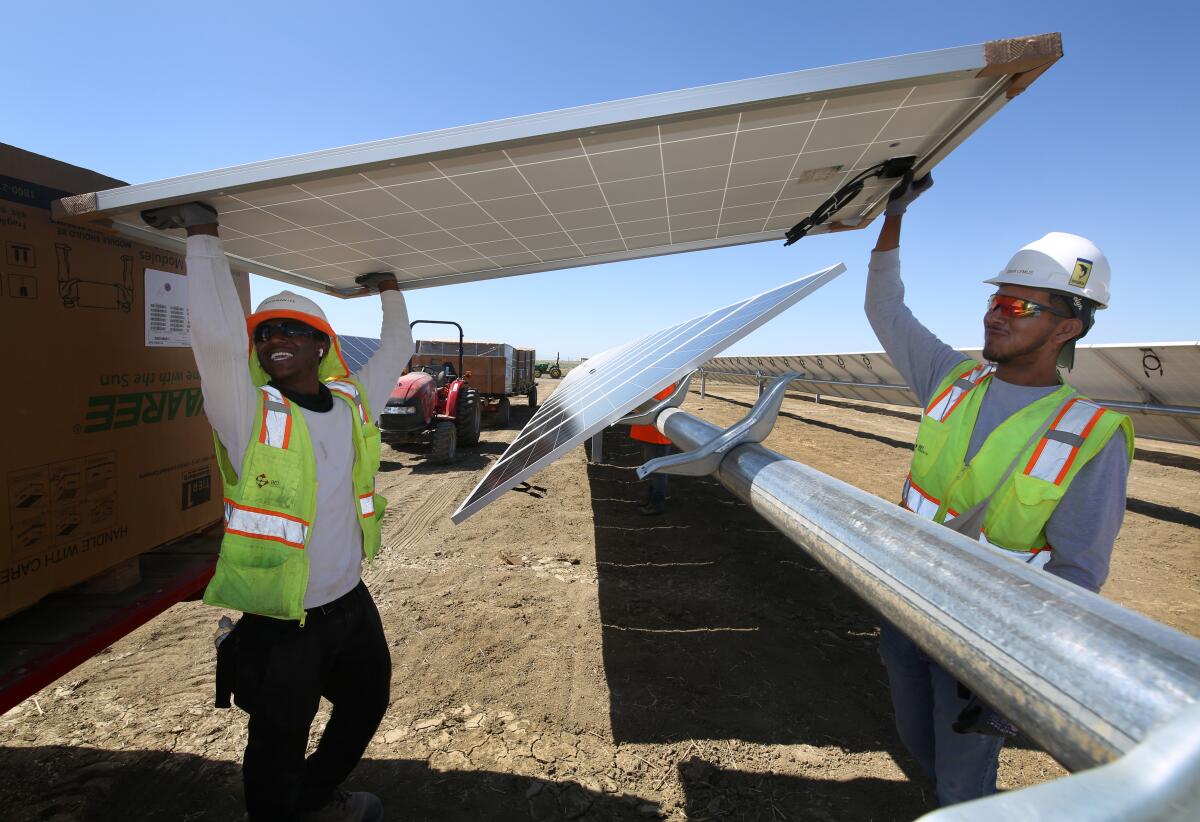
Construction workers Rayshawn Lee and Omar Lemus install photovoltaic panels at Westlands Solar Park in California’s San Joaquin Valley in 2021.
(Gary Kazanjian/For The Times)
One more time, let’s start with some good news.
Through July, California’s main power grid — the one comprising Southern California Edison, Pacific Gas & Electric and San Diego Gas & Electric — had already made it through 100 days this year with at least 100% of its electric demand being met by solar, wind and other climate-friendly energy sources for at least part of the day. That’s according to this story by CalMatters’ Alejandro Lazo.
Renewable power wasn’t quite so robust in other Western states. But it continued to edge out coal, as symbolized by the San Juan Generating Station smokestacks being demolished in New Mexico, as Hannah Grover reports for New Mexico Political Report.
Now the energy challenges:
- “From Ford to Mercedes-Benz, major automakers are walking back aggressive electrification goals they set just a few years ago.” If you’ve been noticing this too, here’s a sharp analysis of what the hell’s going on. (Tim Stevens, Canary Media)
- Regardless of how you feel about the failure of a carbon capture project in Wyoming, the reason for its failure is concerning. The project’s backers couldn’t secure enough clean power — partly due to “competition from other energy-hungry customers such as data center operators.” The more data centers get built to supply artificial intelligence and other digital devices, the more demand there will be for electricity — and the harder it will be to phase out fossil fuels. (Corbin Hiar, E&E News)
- Global methane pollution is rising faster than ever, with two-thirds coming from human sources, new research finds — scary findings in some ways, but also encouraging, because they mean we can slow global warming. (Hayley Smith, L.A. Times)
ON THE LANDSCAPE
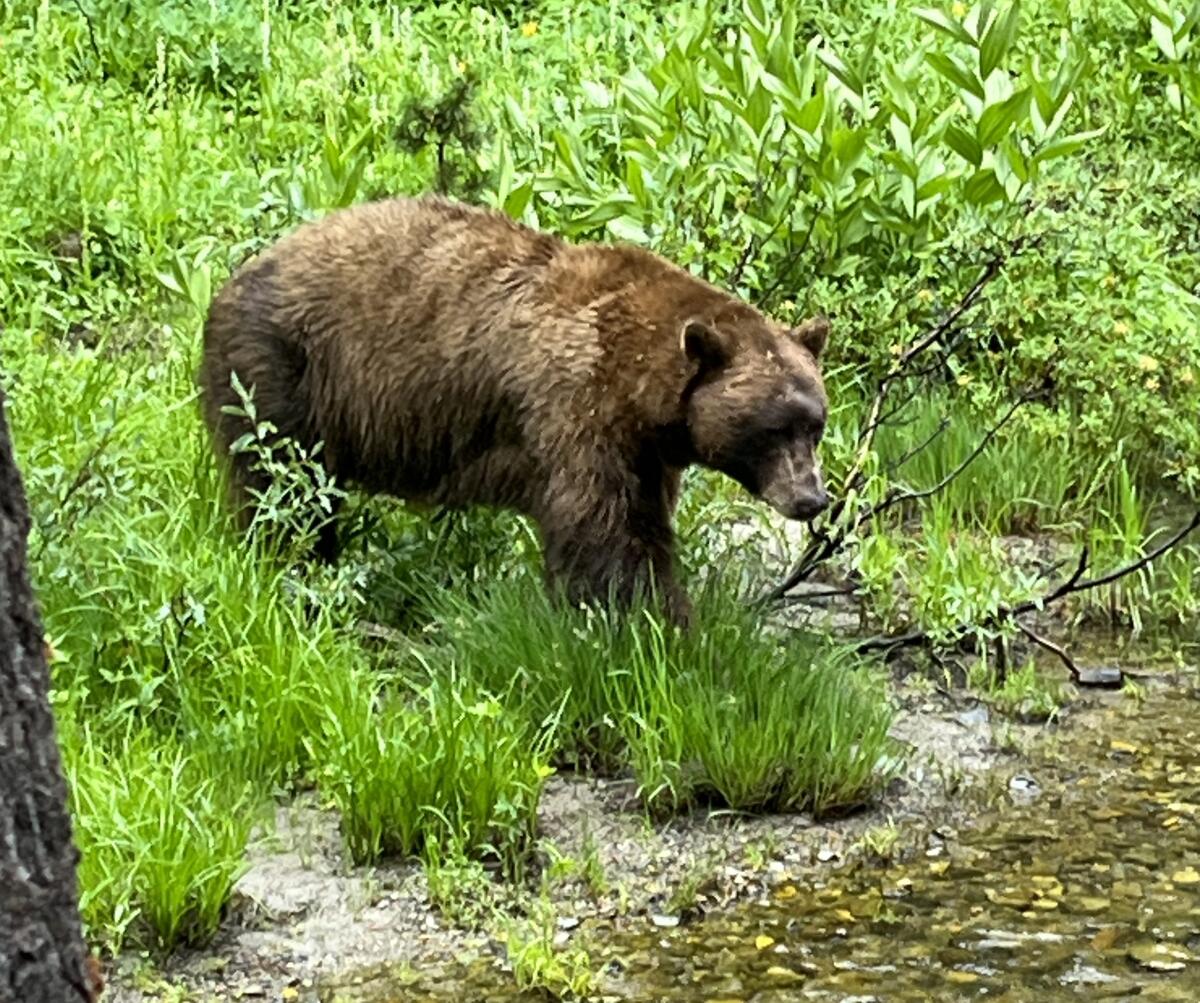
A 500-pound bear, nicknamed Victor, regularly visited Mammoth Lakes campgrounds.
(Courtesy of Kathy Spaulding)
Until next week, a few final stories from the great outdoors:
- Did California wildlife officials make the right decision when they euthanized a black bear known as Victor in the Mammoth Lakes area after the bear attacked a woman at a campground? My L.A. Times colleague Lila Seidman delved into the debate.
- A residential development is moving forward in Southern California after approval by Jurupa Valley City Council, even as some worry it could threaten Earth’s oldest known oak tree. The tree is more than 13,000 years old. (Noah Haggerty, L.A. Times)
- At Joshua Tree National Park, a ranger oversees the Preventative Search and Rescue Program, helping visitors learn to protect themselves from hazards such as extreme heat, sharp cacti and thirsty bees. It’s pretty cool. (Alex Wigglesworth, L.A. Times)
Last but not least, some of my favorite reads over the last months have been “Miles to Go,” a series of deeply reported narratives by Bing Lin for Inside Climate News about the impacts of climate change on the Pacific Crest Trail — as told, in part, through Lin’s own experiences hiking the PCT. The tales range from fascinating to mildly terrifying, including a wildfire near the trail.
I’ll be back on Tuesday — no more vacations for a while. See you soon.
This is the latest edition of Boiling Point, a newsletter about climate change and the environment in the American West. Sign up here to get in your inbox. Or open the newsletter in your web browser here.
For more climate and environment news, follow @Sammy_Roth on X.

